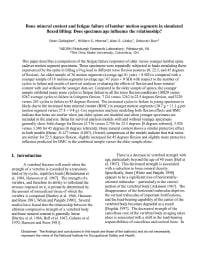Mining Publication: Bone Mineral Content and Fatigue Failure of Lumbar Motion Segments in Simulated Flexed Lifting: Does Specimen Age Influence the Relationship?
Original creation date: September 2005
Authors: S Gallagher, WS Marras, AS Litsky, D Burr
NIOSHTIC2 Number: 20028482
In: Proceedings of the Human Factors and Ergonomics Society 49th Annual Meeting (Orlando, FL, September 26-30, 2005). Santa Monica, CA: Human Factors and Ergonomics Society; :1278-1282
This paper compares the fatigue failure responses of older versus younger lumbar spine cadaver motion segment specimens. These specimens were repeatedly subjected to loads simulating those experienced by the spine in lifting a 9-kg load in different torso flexion postures (0, 22.5, and 45 deg of flexion). An older sample of 36 motion segments (average age 81 years + 8 SD) is compared with a younger sample of 18 motion segments (average age 47 years + 9 SD) with regard to the number of cycles to failure and results of survival analyses evaluating the effects of flexion and bone mineral content (BMC) with and without the younger data set. Compared to the older sample of spines, the younger sample exhibited many more cycles to fatigue failure in all torso flexion conditions (10,020 versus 8,267 average cycles to failure in 0 deg flexion, 7,124 versus 3,262 in 22.5 deg flexion, and 3,229 versus 263 in 45 deg flexion). The increased cycles to failure in young specimens is likely due to the increased BMC in younger motion segments (30.7 g + 11.1 g per motion segment versus 27.8 + 9.4 g). Cox regression analyses modeling both flexion effects and BMC indicate that betas are similar when just older spines are modeled and when younger specimens are included in the analysis. Betas for survival analysis models with and without younger specimens generally show little change for flexion (2.716 versus 2.756 for 22.5 deg (0 deg referent), 3.926 versus 3.380 for 45 deg (0 deg referent)). BMC shows a similar protective effect in both models (betas: -0.127 versus -0.087). Overall, comparison of the models indicates that risk ratios are similar for 22.5 deg flexion, slightly increased for 45 deg flexion, and slightly more protective influence predicted for BMC in the combined sample versus the older sample alone.

NIOSHTIC2 Number: 20028482
In: Proceedings of the Human Factors and Ergonomics Society 49th Annual Meeting (Orlando, FL, September 26-30, 2005). Santa Monica, CA: Human Factors and Ergonomics Society; :1278-1282